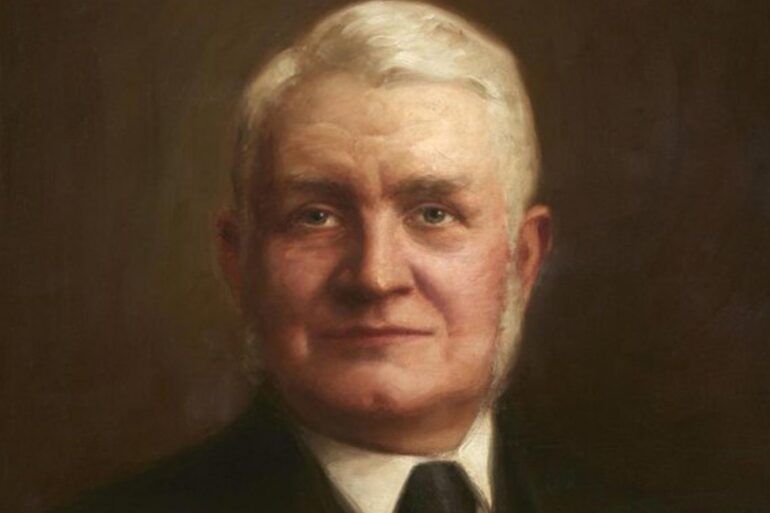Sorting through bank notes next time, one may stand out and that is the Clydesdale Bank five-pound note.
On one side this note depicts the distinctive structure of the Forth Bridge an engineering triumph but who is the gentleman shown on the reverse of the note and what connection does he have to Renfrewshire?
This is Sir William Arrol, the engineer behind the construction of the Forth Bridge which was officially opened on 4 March 1890. His life and career were eventful, and he is recognised even today as a prominent and innovative civil engineer and his story began in Renfrewshire. He was born Houston on 13 February 1839 the son of Thomas Arrol and Agnes Hodgert. By the age of two William’s family had moved to Johnstone where his father who was a cotton spinner. As with many other children of his family circumstances by the age of eight William had started work as a “bobbin boy” in the turning shop of a cotton mill. In the census of 1851, the family were recorded as living at 10 Ferguslie, Paisley. The following year aged thirteen William started as an apprentice with Thomas Reid a local blacksmith.
With only a rudimentary education William applied himself to learn not only a trade but also at night school to master mathematics, hydraulics, and engineering. In his early twenties William travelled to other parts of Scotland and England gathering more experience as a boiler maker and engineer. On 15 July 1864 he married Elizabeth Pattison. By 1868 William started his own boiler makers business in Peel Street, Glasgow. This was followed in 1871 with an expansion of the business to new premises at 309 London Road where twenty men and four boys were employed in the Dalmarnock Iron Works.
William’s reputation for innovative use of new materials and engineering techniques combined with design and use of new forms of mechanical machinery and an entrepreneurial ethos in business saw the first of many large-scale civil engineering contracts being awarded. This was the contract to build the Bothwell viaduct over the River Clyde in 1875. Over the following years many more prestigious engineering contracts followed including the construction of the second Tay rail bridge, the Forth Bridge and the Tower Bridge over the Thames in London. Soon after the official opening of the Forth Bridge in1890 he was knighted and became known as Sir William Arrol.
In the mid 1880’s William moved to a large property equal to his new rank in Ayrshire called Seafield House. In his later years William was awarded a doctorate from the University of Glasgow, freedom of the royal burgh of Ayr and in 1890 he became a director of J & P Coats thread manufacturing business in Paisley. Further in 1895 he was elected as MP for the South Ayrshire parliamentary constituency remaining in this position until 1906. His interest in new engineering innovations also led him to enter a partnership with Sir Thomas Glen-Coats and others to support the Mo-Car Syndicate to manufacture cars. From 1895 to 1913 William supported the venture known as the Arrol-Johnston Company based for some time at what had been the Underwood Mill premises in Paisley.
In 1904 Sir William Arrol & Co built the bridge over the Nile in Egypt followed in 1908 by the erection of the gantry at the Harland & Wolf shipyards in Belfast ready for the construction of the Titanic.
William was widowed in 1904. On 8 March 1905 he married for a second time to Miss Janet Hodgart. This marriage however was short-lived as his second wife died in 1910. On 16 November 1910, William married a third time to Miss Elsie Robertson.
Sir William Arrol died on 20 February 1913 at the age of seventy-four at Seafield House. He is buried at Woodside in Paisley. He had no children and his will provided for his wife, nieces and nephews and some beneficiary hospitals and institutions.
Sir William Arrol was a giant in the field of civil engineering, and rightly is depicted on a national bank note. An illustrious life which started very humbly in Renfrewshire.
